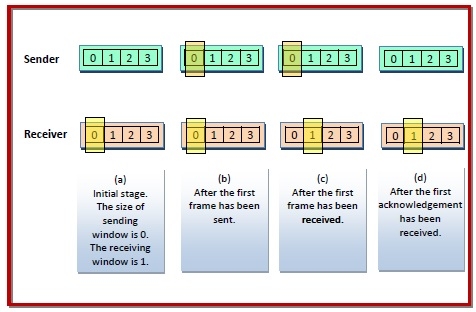
 Data Structure
Data Structure Networking
Networking RDBMS
RDBMS Operating System
Operating System Java
Java MS Excel
MS Excel iOS
iOS HTML
HTML CSS
CSS Android
Android Python
Python C Programming
C Programming C++
C++ C#
C# MongoDB
MongoDB MySQL
MySQL Javascript
Javascript PHP
PHP
- Selected Reading
- UPSC IAS Exams Notes
- Developer's Best Practices
- Questions and Answers
- Effective Resume Writing
- HR Interview Questions
- Computer Glossary
- Who is Who
A One-Bit Sliding Window Protocol
Sliding window protocols are data link layer protocols for reliable and sequential delivery of data frames. The sliding window is also used in Transmission Control Protocol. In these protocols, the sender has a buffer called the sending window and the receiver has buffer called the receiving window.
In one – bit sliding window protocol, the size of the window is 1. So the sender transmits a frame, waits for its acknowledgment, then transmits the next frame. Thus it uses the concept of stop and waits for the protocol. This protocol provides for full – duplex communications. Hence, the acknowledgment is attached along with the next data frame to be sent by piggybacking.
Working Principle
The data frames to be transmitted additionally have an acknowledgment field, ack field that is of a few bits length. The ack field contains the sequence number of the last frame received without error. If this sequence number matches with the sequence number of the frame to be sent, then it is inferred that there is no error and the frame is transmitted. Otherwise, it is inferred that there is an error in the frame and the previous frame is retransmitted.
Since this is a bi-directional protocol, the same algorithm applies to both the communicating parties.
The algorithm of One – bit Sliding Window Protocol
begin frame s, r; //s and r denotes frames to be sent and received SeqNo = 0; // Initialise sequence number of outbound frame RSeqNo = 0; // Initialise sequence number of expected frame while (true) //check repeatedly do Wait_For_Event(); //wait for availability of packet if ( Event(Request_For_Transfer) AND canSend) then Get_Data_From_Network_Layer(); s = Make_Frame(SeqNo); Store_Copy_Frame(s); Start_Timer(s); SeqNo = SeqNo + 1; end if; Wait_For_Event(); //wait for arrival of frame if ( Event(Frame_Arrival) then r = Receive_Frame_From_Physical_Layer(); if ( r.SeqNo = RSeqNo ) then Extract_Data(r); Deliver_Data_To_Network_Layer(r); Stop_Timer(r); RSeqNo = RSeqNo + 1; end if end if s.ack = r.SeqNo; Send_Frame_To_Physical_Layer(s); Start_Timer(s); SeqNo = SeqNo + 1; end while end
Illustrative Example
The following diagram depicts a scenario with sequence numbers 0, 1, 2, 3, 0, 1, 2 and so on. It depicts the sliding windows in the sending and the receiving stations during frame transmission.


